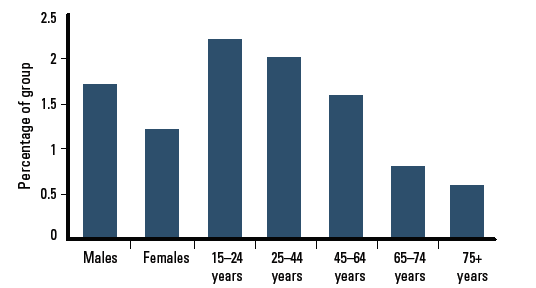Men accounted for 53% of the 1325 patients at encounters for sprain and strain. Sprain/strain was managed for 1.7% of men, which was significantly more than for women (1.2%). As would be expected, the highest proportion of patients having a sprain or strain managed were those aged 15–24 years (2.2% of patients in this age bracket) and those aged 25–44 years (2.0%). The management rate was significantly lower among patients aged 65–74 years and those aged 75 years and over, at 0.8% and 0.6% of patients in these age groups (Figure 1). Compared with the average at BEACH encounters, patients with sprains and strains managed were less likely to carry a Commonwealth healthcare card, and encounters were nine times more likely to be funded by workers’ compensation, reflecting the younger patient profile. Sprain/strain of the spine was common, accounting for 29% of the injuries. Sprain/strain of the shoulder (19%), muscle (16%), ankle (15%), wrist (5%) and knee (3%) were also recorded.

Figure 1. Proportion of patient-group managed for sprain/strain
Management of sprains and strains
A high percentage (65%) of sprains and strains presented as new problems, and 19% were work related. The medication rate was not as high as the BEACH average. The most common medications prescribed, advised or supplied were paracetamol and ibuprofen. Procedural treatments for sprain/strain were recorded at the high rate of 26 per 100 sprain/strain problems, top of the list being physical medicine and rehabilitation such as therapeutic exercises, and bandage/compression. Referrals to allied health professionals were given at a high rate, most of these to physiotherapists. Imaging was ordered at a rate four times the BEACH average and there was little difference between rates for ongoing or new cases of sprain and strain. Ultrasound of the shoulder was the most common imaging test ordered, followed by X-ray of the ankle and X-ray of the shoulder (Table 1).
Table 1. Details of sprain/strain management
| Management type | Rate per 100 sprain/strain problems (n=1325) |
|---|
| Medications (all) |
58.8 |
| Paracetamol |
11.9 |
| Ibuprofen |
10.3 |
| Procedures |
25.7 |
| Physical medicine |
12.5 |
| Bandage/compression |
7.2 |
| Allied health referrals |
12.5 |
| Physiotherapy |
10.8 |
| Imaging |
27.3 |
| Ultrasound shoulder |
6.1 |
| X-ray ankle |
5.3 |
| X-ray shoulder |
4.5 |
| X-ray wrist |
1.9 |
Acknowledgements
The authors thank the GP participants in BEACH and all members of the BEACH team. Financial contributors to BEACH 2010–11: Australian Government Department of Health and Ageing; Australian Government Department of Veterans’ Affairs; AstraZeneca Pty Ltd; Bayer Australia Ltd; CSL Ltd; GlaxoSmithKline Australia Pty Ltd; Merck, Sharp and Dohme (Australia) Pty Ltd; Novartis Pharmaceuticals Australia Pty Ltd; Pfizer Australia; Sanofi-Aventis Australia Pty Ltd.